Originally Posted At: https://breakingmuscle.com/feed/rss
A considerable amount of research has been conducted on the concept of periodization and its function in organizing training programs, particularly for eliciting athletic performance gains.
http://www.marksdailyapple.com/

Off the bat, I should say that I’m actually a fan of eating less. I’m on record as saying that my goal is to figure out how few calories I can eat and still thrive. Still, eating less isn’t always the magic bullet people will hope it will be. There are many ways that eating less can go wrong.
For weight loss, the advice to “eat less, exercise more” often doesn’t work like it “should” on paper. The weight-loss diet industry thrives on repeat customers who struggle to lose weight and keep it off. Dutifully following this strategy has led many people down the road to frustration and dejection, as they blame themselves for their failure to successfully lose weight. This is despite their best efforts to eat less.
From a health perspective, eating less is a double-edged sword. On the one hand, caloric restriction may promote longevity. It certainly does in many animal models. Human evidence is still mixed, but I’m betting that the same is true for us.1 On the other hand, long-term or severe calorie restriction can cause serious health problems, including nutrient deficiencies, hormonal imbalances, and muscle loss.
Today I’m going to look at some of the ways that restricting calories can go wrong—or simply be ineffective—as well as ways to eat less to actually promote health.
Instantly download our FREE Guide to Gut Health
Don’t get me wrong. At the end of the day, if you’re trying to lose weight, the body must expend more energy than it takes in. I’m not talking here about the oversimplified CICO—calories in versus calories out—approach to weight loss. Calories are just one variable in the incredibly complex equation that ends in weight loss. I’m talking about more valid but harder to quantify balance between energy consumed and energy expended.
In both cases, the idea behind eating less is to put fewer calories (or less energy) into the system. However, the energy balance approach recognizes that:
Oftentimes, when someone is struggling to lose weight, they’ll get, “You’re just eating too much. Eat less, and you’ll start losing.” This person might already be down to 1100 or 1200 calories per day. They’re thinking, “How can I possibly eat less and still have the energy to get through my day?” The advice-giver doesn’t understand how the body adapts to calorie restriction.
One of the reasons that weight loss is so difficult is that your body actively fights back against it. It makes sense if you think about it. The body stores fat for times of famine. It doesn’t know (or care) if it has stored “too much” according to your personal preferences. When you intentionally try to lose weight, your body “defends” its body weight by altering the amount of energy it expends.2 It tries to tightly ration body fat in case you’re facing a prolonged food shortage.
Let’s back up. The “energy out” side of the energy balance equation comprises several factors:
When you eat in a caloric deficit and start to lose weight, the body responds by lowering its metabolic rate. That’s actually desirable from an aging perspective. Reduced metabolic activity and subsequent lower oxidative stress might explain why caloric restriction promotes longevity.4 It’s not so great when it comes to weight loss.
Moreover, the body responds to caloric restriction by dialing back activity. “Non-exercise activity thermogenesis,” or NEAT, is the term for the energy you expend through spontaneous movements like tapping your feet or nodding your head along to music. NEAT can vary up to 2000 calories per day between individuals.5 That’s a massive difference in “energy out.” It gives your body a little of wiggle room when it comes to reducing energy expenditure.
These metabolic adaptations aren’t inherently bad. One reason your metabolic rate goes down as you lose weight is simply that smaller bodies expend less energy. Unfortunately, though, it’s also a coordinated attempt to thwart your ongoing weight loss efforts. This is why weight loss is so tricky. There are things happening under the hood that you can’t monitor. Eating less can actually increase your body’s adaptive response, making it harder and harder to lose weight.
Another reason the advice to “just eat less” fails dieters is because people are notoriously bad at judging how much they actually eat. In studies, participants chronically underreport their caloric intake, even when they are paid to be accurate6 and when they are dieticians.7
If you’re also trying to balance your food intake against estimates of how many calories you burn through exercise, fuggedaboutit. One study found that individuals believed they burned three times more calories than they actually did on a treadmill test.8 Another small study showed that individuals who were struggling to lose weight underreported their caloric intake by 47 percent and overestimated energy expended by 51 percent, on average.9 (It’s not you. Activity trackers are notoriously terrible at accurately estimating calorie burn.10)
Even if you’re diligently weighing and tracking your food, you’ll probably be off through no fault of your own. The FDA allows a margin of error of up to 20 percent for calories reported on food labels.11 Packaged meals and restaurant meals often contain many more calories than stated on labels and menus. 12 13
What you really want is fat loss. Nobody is striving to lose lean muscle or organ tissue or bone mass. Unfortunately, that’s often exactly what happens when people restrict calories too much and for too long without taking great care with what they are eating.
There are lots of ways to eat less. You can start your day low-fat, “heart healthy” (eye roll) cereal and skim milk, drink a smoothie for lunch, and have plain chicken breast and steamed broccoli for dinner. Or, you can eat in a compressed eating window, enjoying eggs, chicken thighs, steak, fatty fish, and abundant vegetables. Only one of these options will get you sufficient protein, healthy fats, and lots of vitamins, minerals, and phytonutrients to mitigate non-fat loss.
Not surprisingly, hunger is a common complaint among people who are trying to restrict calories. Besides being unpleasant, excessive hunger can derail your efforts by causing you to unintentionally eat more. You take a slightly bigger portion, grab a handful of nuts in between meals, and eventually devour the ice cream hidden in the freezer. Those calories add up.
Some hunger is to be expected if you are eating in a caloric deficit (although there are ways to attenuate hunger that I’ll discuss later). Excessive hunger is a problem, and a sign that you’re overdoing it.
Leptin is one of the hormones responsible for regulating appetite. It’s considered an energy indicator, communicating to the brain whether you have sufficient energy on board. When you’re losing weight—specifically when body fat is on the decline—leptin drops.14 In fact, it drops more than would be predicted by body composition alone.15 It seems to be signaling to the brain, “Hey, we’re losing our fat stores over here! Send help.” If leptin gets too low, all hell can break loose. Symptoms of low leptin include hunger, depression,16 loss of libido, and infertility.17
Going too low on calories can also depress thyroid function. In particular, lower T3 seems to be related to calorie restriction even without weight loss. I’m not convinced this is necessarily a bad thing. It may actually be adaptive—another pathway by which caloric restriction increases longevity.18 That said, you can definitely have too much of a good thing. You don’t want to restrict calories to the point where you start experiencing symptoms of hypothyroid such as feeling cold all the time, unexplained weight gain, or fatigue.
I’ve said it a million times: stress is the enemy of health and weight loss. As with so many things in life, calorie restriction can be an adaptive (hormetic) or maladaptive stressor. It all depends on how it’s applied and how your body reacts.
Restricting calories increases cortisol, aka “the stress hormone.”19 Chronically high cortisol leads to problems including:
I know, this sounds like a good thing. If you’re trying to eat less, isn’t it better if your appetite is reduced? Yes… to a point. Anecdotally, I see a subset of people whose appetites are suppressed when they restrict calories—possibly due to being in ketosis20—and who subsequently struggle to eat enough. If they aren’t mindful, they can easily under-eat to the point they are getting enough nutrients.
If you suspect you might be under-eating, use an app like Cronometer to track your food for a few days. Make sure you are checking the nutritional boxes you need to stay healthy.21
Caloric restriction can lead to your body catabolizing muscle tissue if you’re not careful. Some muscle breakdown is probably unavoidable, especially if you are losing substantial amounts of weight, but you want to mitigate it as much as possible. Protein intake is key. Eating more protein protects lean mass (muscle and organs), even when you’re in a caloric deficit and losing weight.22 23
When you eat less, make sure you aren’t cutting your protein precipitously. You may even want to increase it a bit.24 Your calorie deficit should come from reducing fat and/or carbs, depending on your current diet.
Dieting forums are filled with dire warnings against dieting so long or so hard that you go into “starvation mode” and create permanent “metabolic damage.”
You might be familiar with the highly publicized Biggest Loser study, which followed contestants from the televised weight loss competition.25 The researchers found that six years after losing significant weight, the contestants’ resting metabolic rate was on average 500 calories lower than would be predicted based on their size. That meant they had to eat many fewer calories (and/or burn more) just to maintain their weight, compared to people with similar body compositions who hadn’t lost a bunch of weight. In fact, many of them regained significant weight in the six years after the show ended.
As I said above, it’s well established that the body defends against weight loss by slowing metabolic rate and reducing energy expenditure. Other studies have shown that this metabolic adaptation persists even when people maintain or start to regain weight.26 27 28
Whether this constitutes permanent metabolic damage is a hotly debated topic. A recent paper called the notion into question. 29 The authors reanalyzed data from several studies that purportedly showed persistent metabolic downregulation. Using different equations that took into account participants’ body composition, they concluded that given enough time, metabolism will revert back to pre-weight-loss levels. Even the men from the most extreme weight loss experiment to date, Ancel Keys’s Minnesota starvation study, recovered eventually.
I’m not convinced that caloric restriction “breaks” your metabolism by any means. Still, if you engage in sustained caloric restriction and weight loss, there will likely be a period in which your metabolic rate is reduced. That means if you go right back to eating as much as you were before, you’ll regain weight. It seems to the trade-off.
The less you eat, the more every bite counts. Make the most of the calories you eat by prioritizing nutrient density and getting sufficient protein. Although I embrace fat in my diet, it’s the cherry on top, not the main course. I fill my plate with nutrient-dense meat, seafood, and poultry; eggs; and abundant veggies. Then I add sauces, dressings, and condiments (Primal Kitchen, naturally) for flavor and interest.
Prioritizing nutrient-dense foods ensures that you are being nourished on a cellular level. Consuming mostly low-protein, low-fat, low-nutrient foods will leave you hungry, unsatisfied, and craving more. There’s a reason that physique athletes only follow the “chicken breast and steamed broccoli” diet for short periods before competitions. It’s miserable. It messes with sleep, sex drive, and mood. You’re hungry all the time. It’s no way to live.
Eating sufficient protein increases satiety30. It helps keep your metabolic rate up by protecting energy-guzzling muscles and organs. Protein also has a higher thermic effect than fat or carbs, further contributing to metabolic rate.31
If you’re chronically in a caloric deficit, say 15 to 20 percent or more, you may benefit from cycling in periods where you eat at maintenance calories. That means you try to eat about the same number of calories you need to break even each day. Obviously you can’t know exactly how much energy you’re expending, but you can use an online calculator to get a rough estimate. It doesn’t matter if you’re spot on.
The idea here is to “reset” your hormones, especially leptin and thyroid hormones. This will also bring your metabolic rate back toward baseline, although it will decrease again once you go back to a caloric deficit.
There’s also something to be said for taking a mental break from restricting calories. Especially if you feel stressed, or you simply get tired of feeling hungry, loosening the reins periodically is a good idea. Stress counteracts the benefits of any diet or lifestyle intervention, including calorie restriction.
There are many ways to execute cyclical dieting. Go with whatever style works best for you. A popular method is 8 to 10 weeks of caloric deficit followed by 2 weeks at maintenance, and repeat. A word of caution, though: Those maintenance weeks aren’t meant to be free-for-alls. Sure, you can enjoy some foods you avoid during the deficit phase. It’s no big deal if you eat somewhat above maintenance some days. Eating 10,000 calories in a weekend can quickly wipe out a few weeks’ worth of caloric deficit, though. If you’re trying to lose weight, you’ll be taking three steps forward, and two (or three!) steps back if you do this. If you’re going for longevity and general health benefits, it doesn’t make sense to binge on inflammatory foods.
As I mentioned, ketones are known to suppress appetite, which can lead to a spontaneous reduction in calories. If you are struggling with hunger but still eating a moderate- or high-carb diet, consider doing a Keto Reset. Drop your carbs to 50 grams or less. Increase your fat proportionately. (Carbs have 4 calories per gram, while fat has 9 calories per gram. If you reduce your carb intake by 50 grams, that’s 200 calories—about 22 grams of fat.)
Anecdotally, lots of people report that they find it much easier to sustain a caloric deficit on keto. They no longer feel like they are white-knuckling it and relying on willpower. If you have questions about going keto, head to my keto diet hub and grab my free Beginner’s Guide to Keto.
Many people find it easier to eat less when they observe a shorter eating window. Start slowly. If you currently eat between 8 a.m. and 8 p.m.—a 12-hour window—see if you can shorten it by an hour or two. Six- and eight-hour windows are common, but there are no hard and fast rules about what’s optimal. As with keto, intermittent fasting isn’t for everyone, and you have to make sure you’re eating enough in your window.
If you’re eating less for longevity purposes, fasting may give you an extra boost in the autophagy department.
Trying to starve yourself into rapid weight loss is a bad idea. Hopefully that goes with saying. A modest caloric deficit with periodic breaks seems best in most cases.
As always, you should experiment and see what works for you. Especially when it comes to longevity, we don’t have enough solid evidence from human studies to lay out a specific calorie restriction protocol that is optimal. We probably never will given the tremendous variability between people.
Although caloric restriction has benefits, it’s a means to an end. Like carb restriction, intermittent or extended fasting, HIIT, it’s a tool in your metabolic toolbox. Use it appropriately, enjoy the benefits. Apply it too much or in the wrong situations, and you risk digging yourself into a hole.
Be patient. Stack the odds in your favor by eating satiating, nutritious foods, and by doing all the “other stuff” that supports metabolic health—getting plenty of sleep and sun, exercising appropriately, moderating stress. Resist the temptation to double down on restriction when your body needs a break. Control the variables you can control and make peace with the outcome.
7 Common Calorie Myths We Should All Stop Believing
9 More Calorie Myths We Should All Stop Believing
Dear Mark: Am I Eating Too Little Food or Too Much Iron?
Top 14 Ways to Increase Your Metabolism
The post Why Eating Less Doesn’t Always Work appeared first on Mark’s Daily Apple.
Originally Posted At: https://breakingmuscle.com/feed/rss
I set a lot of physical goals. I feel like I have to keep from being a fraud given my job. I’ve woken up more days where I was disinterested in following through than not. I don’t repeat affirmations or watch videos of hero workouts set to motivational music. I flip on Casablanca.
http://www.marksdailyapple.com/

You’re doing the best you can.
You’re trying to stay at home. You’re homeschooling the kids. You’re trying to keep working at your job, or you’re navigating the waters of having lost employment. You’re trying to remain upbeat and optimistic.
There’s a lot of juggling going on, and if there’s one thing I’ve learned in my 25+ years in the health and fitness industry, it’s that the first ball we let drop is our own – our self-care.
You may start each day with grand plans for a healthy dose of movement. You may have visions of a long, brisk walk. You may decide that today’s going to be the day you dust off the Bowflex or your dad’s ancient dumbbels in the basement. Whether it’s because you’ve run out of time, energy, or steam, or because your sense of overwhelm is holding you down like lead, perhaps you’re not taking as much care to get your body moving these days.
This has implications for your energy. Energy moves through the body freely when the body is open and unblocked. More energy begets more energy: once you’ve got it flowing, you’ll find yourself coming back
online; fully charged.
I’ve created the following yoga sequence precisely to help unlock energy and relieve the pressure you’re feeling in your head and heart, and that’s locked up inside your body. This sequence is simple, slow, and low-stress; designed to feel like an exhilarating and relaxing deep sigh.
And we could all use a deep sigh right about now.
So get down on the floor (you don’t even need a yoga mat) and do as many of these easy, feel-good postures as you can, for as long as it feels good.
Many yogis affirm that our hips are the spot in our body where we hold much of our emotional and spiritual tension. Whether that sounds plausible or far-fetched to you, there is simply no denying that hip opening yoga postures feel darn good.
So in this series, we’ll focus predominantly through the big hip joints, while also flowing through some spinal rolling. Let’s get your energy flowing again. You can complete the whole sequence in less than 30 minutes; a perfectly affordable amount of time to spend on yourself.
I’ve created short instructional videos for each couplet. I encourage you to linger in each pose of each sequence as long as you like (I move through them more quickly in the videos, in the interest of brevity). This
isn’t meant to be a heart-pumping workout. It’s an exercise in self-kindness; slow and gentle is the name of the game.
I hope it helps you feel better!
——-
Repeat this sequence as many times as you like until your back and hips feel warm and juicy. Observe how the first round feels. Observe how this improves in the second round, the third, and so on.
On the spinal curls, imagine each of your spinal vertebrae rolling up, one at a time, like a string of pearls. Concentrate on moving each one independently of its neighbors.
In the forward fold, allow your head, shoulders, and arms to hang very heavily, as dead weight, enabling a sensation of traction within the spine.
In garland pose, press your knees out with your elbows, drop your tailbone toward the floor, and try to lift the crown of your head toward the ceiling. If garland pose is eluding you today, take child’s pose and settle right down into the floor. Be sure to emphasize the length of your spine by reaching the arms very far forward, and sending the hips very far back.
In the upright version of the lunge, reach the same arm as the downward leg as high as you can. You may choose to lean away, to add more length to the stretch in the front hip.
In the low lunge, bring your arms to the inside of the forward leg. You can remain up on your hands with straight arms, or play around with bending your arms a bit to drop even lower. You may even be able to take your elbows to the floor. Don’t feel the need to push it. This is meant to be gentle.
Linger as long as you like in each lunge, repeating the sequence on the other side.
To get into frog pose, put your elbows on the floor, then take your knees wide, your ankles wide, and your toes wide (you may wish to double up the mat under your knees or put a pillow under each knee for comfort on a hard floor). Lightly press into your elbows to send your hips and tailbone slightly backward. It doesn’t take long for frog pose to feel intense. Come out of it when you’re ready for a break.
Then move into this very wide-legged version of child’s pose by shifting your weight slightly forward from frog pose, and bringing the tips of your toes together behind you. Keep the knees wide. Reach your arms as far out in front of you as you can. Settle your body into the floor in between your knees.
Repeat this sequence as many times as you like.
Don’t worry if your half lotus or pigeon look a little rougher than what you see on Pinterest. You’re working with what your body is giving you today and that is perfectly enough. Concentrate on how it feels, on letting go of any “hold” though the hips, and in the breath.
Half lotus can be done with the ankle stacked up on the opposite knee, or for a little easier option (depending on how your hips and knees feel) take the ankle to the opposite calf. Can’t manage half lotus? Simply sit cross-legged with one leg folded in front of the other.
In pigeon pose, try your best to extend your leg as far back behind you as you can, allowing your kneecap and all five toenails to anchor to the floor. You can remain upright, fold down to your elbows, or bring your forehead to the floor.
Take your time allowing gravity to sink your pigeon ever-closer to the floor, then repeat on the other side.
“Head to knee” is merely a suggestion. A directional aspiration, if you will. Your head does not need to make contact with your knee, but behave as if that’s your desired outcome.
You may find the seated side bend a little “sticky;” I do too. Don’t worry if you can’t get over very far. Rather than leaning to the side, imagine curling your trunk over in a C shape. Observe how your body is suspended by the muscles and connective tissue in your side trunk and see if, with each subsequent round, you can’t bend a little more.
Feel free to cycle back and forth between these two postures, and don’t forget to switch sides. Observe how one side feels compared to the other.
Your spine has 33 individual vertebrae, 17 of which make up the mobile and bendy part of a healthy back. This final sequence is designed to deliver on the spinal suppleness that is your birthright.
As you curl your spine in and out, can you imagine all 5 of your lumbar (lower back) vertebrae and all 12 of your thoracic (middle and upper back) vertebrae moving, one at a time? Observe where you get stuck. On each subsequent curl, observe whether that stickiness begins to loosen up. Complete several rounds of these curls before moving to the twist.
Hug your knees into your chest and then simply allow your bent legs to fall to one side, while keeping your shoulders anchored square to the floor. The weight of your legs will help deepen into this very gentle spinal twist. Switch sides when it feels good.
————
One you’ve finished your sequences, lay quietly or come to seated, and simply observe how different your body feels, and how different you feel in your body. Then go about the business of managing the challenges of the current day, with renewed, flowing energy.
The post Easy At-home Yoga Sequence to Relieve Pressure appeared first on Mark’s Daily Apple.
http://www.thealternativedaily.com/
Have you heard of moringa? The moringa tree is native to northern India, but today it is common throughout the tropical and sub-tropical regions of Asia, Africa, and Latin America. This fast-growing, drought-resistant tropical tree has edible leaves that are one of the world’s most nutrient-dense foods. Other edible parts of the tree include the […]
Originally posted at: http://www.nerdfitness.com/
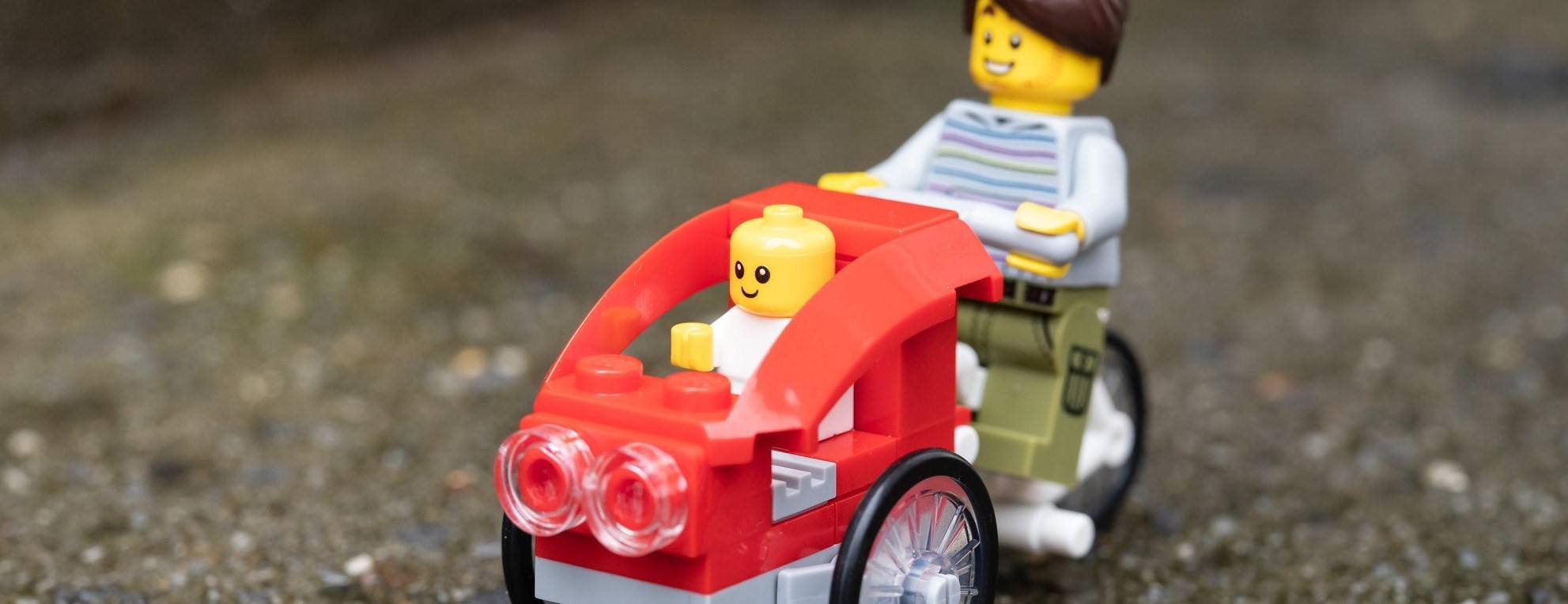
So you’ve got kids running around the house…
And you need to work out, but can’t seem to distract the little monsters any longer?
No problem!
We’ve been teaching people how to exercise at home since 2009. These days, since everyone’s trapped together, we’ve been sharing fun ways to get the kids involved too.
If you need some ideas on how to work out as a whole family, this guide is for you.
(Sign up in the box below and I’ll send you even more home workout goodies).
Here’s what we’ll cover in today’s guide:

Quite a few of our Nerd Fitness Coaches are parents, so they know firsthand how challenging it can be to train while you have a three-year-old running around in the background.
When I asked them for advice for this guide, the most common response I received went something like:
“During quarantine, life is going to be chaos. This is not normal, and neither will your workout be. That’s okay. Do the best you can.”
In other words, it might be challenging to hit personal records (PRs) in your deadlift while also watching over a four-year-old (if you somehow managed to score home gym equipment).
This doesn’t mean “Don’t bother working out.”
It just means you should forgive yourself ahead of time if all doesn’t go according to plan.

If you want proof of how working out with kids can be “a hot mess,” watch Coach Matt exercising with his young children.
The video is all sorts of adorbs.
THE BEGINNER BODYWEIGHT WORKOUT (KIDS EDITION):
When working out with kids, remember:
#1) Meet kiddos where they are. For young kids, invite them to be a partner. Maybe they can count your reps, tell you when to start, etc.
On the other hand, older kids might be able to participate more fully, and maybe even train alongside you.
No matter what, it’s a good idea to invite kids to join when and IF they want, without requiring it.
#2 ) While every kid is different, here are some very general guidelines from Coach Matt’s experience:
#3) Consider a focus on skills/practice. It can be really frustrating to have a timed exercise or workout interrupted.
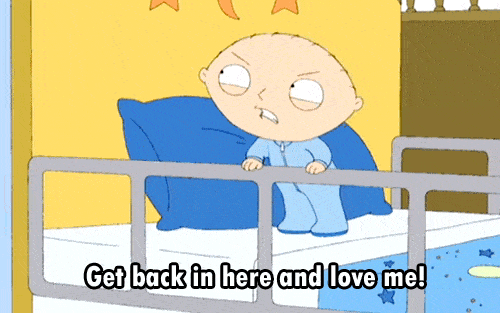
Instead, consider thinking of it like “practice time” of building a skill. You can practice for a couple of minutes, take a break, come back to it, etc.
Kids might respond better to “skills” training instead of “exercises” too. Together, you can practice:
This might go over better than “let’s do squats” or “push-ups.”
#4) There are lots of different ways to get workouts in throughout the day:
#5) Whatever happens is okay! Remember, do the best you can, and it’s perfectly fine if your workout gets cut short because your kid starts drawing on the walls.

If your kids are light enough, you can actually use them as makeshift weights during your workout.
Just be careful, and if anything feels unsafe, don’t do it.
But if things DO feel good, here are some exercises you can do along with kiddos (or using them as weight).
#1) Bodyweight Squats (with Child)
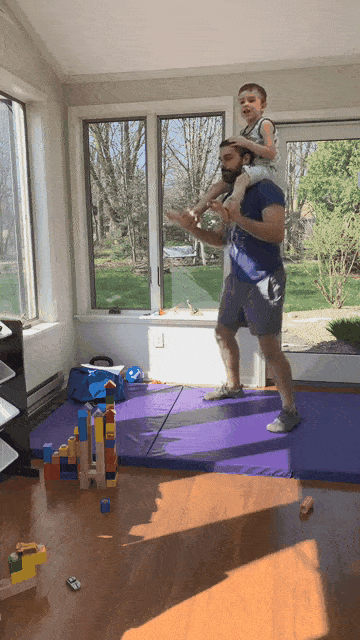
This is much like a normal bodyweight squat, but with your kids sitting on your shoulders.
Coach Matt recommends having your kid’s legs come forward, and for you to grab them, almost like you would with a safety squat bar.
Before attempting this, make sure you can do squats with comparable weight!
#2) Lunges
Much like the bodyweight squats above, but instead do a lunge:
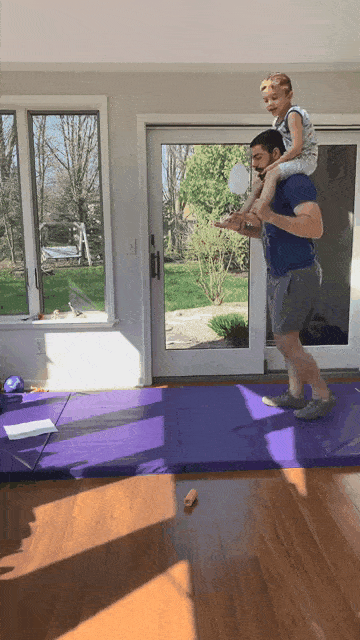
Since you’re engaging one leg at a time, this can be really challenging with a kid on your shoulders.
#3) Touch the Sky
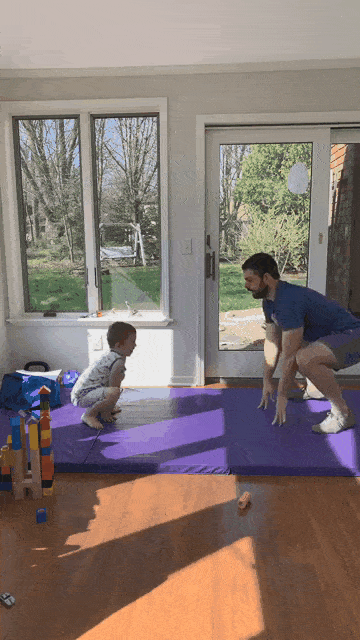
As Coach Matt explains, getting young kids to do squats and push-ups might be tough.
But kids do like to jump!
For “Touch the Sky,” sit in a squat or frog position. Then stand-up tall, arms reaching towards the sky.
Bonus points if you jump up!
This will train many of the same muscles as you would with squats.
#4) Jumps
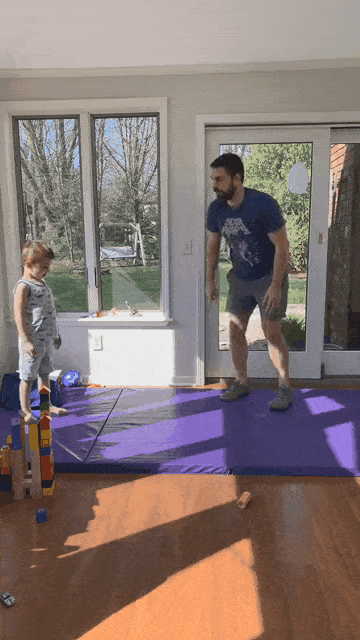
Another good squat substitution to try with kids is long jumps!
You probably want to try this on some type of soft surface (or in your backyard), like the tumbling mat Coach Matt uses. As long as it’s safe, jumping can be really fun with kids.
Make a game out of it, by pointing to a line (or marking one with a soft object) and seeing who can jump over it. You’ll not only train your lower body with jumps, but you’ll also build some explosive power.
#5) Push-ups
You have a few options here.
The first, is to have your kid crawl on your back, and use them as a weight:
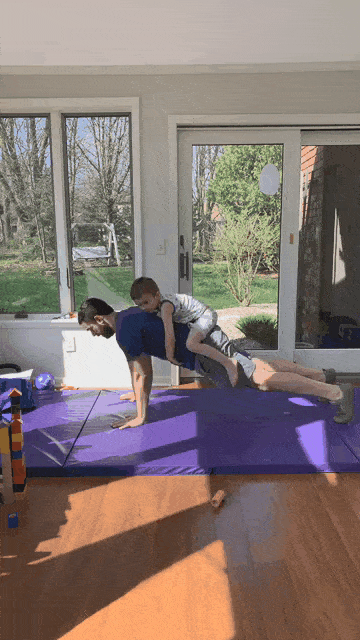
Feel free to do knee push-ups here too if it’s a little too challenging.
The next option is to include your kid in the workout by giving them high-fives between reps:
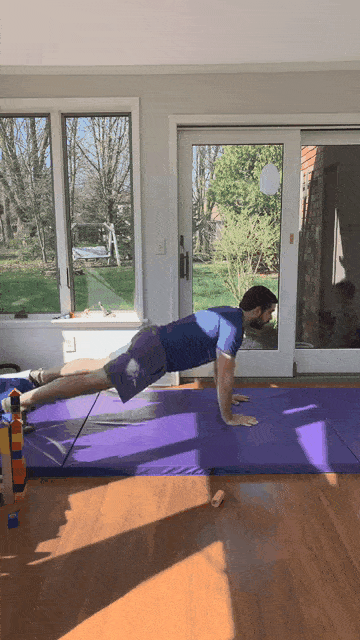
Lastly, you can have your kids crawl under you between repetitions, trying to worm their way from one end to the other:
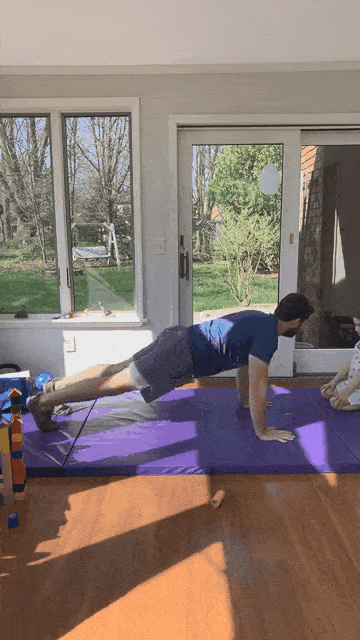
#6) Bear Crawl
A fun exercise to do with your kids is to crawl around like a bear with them latched on!
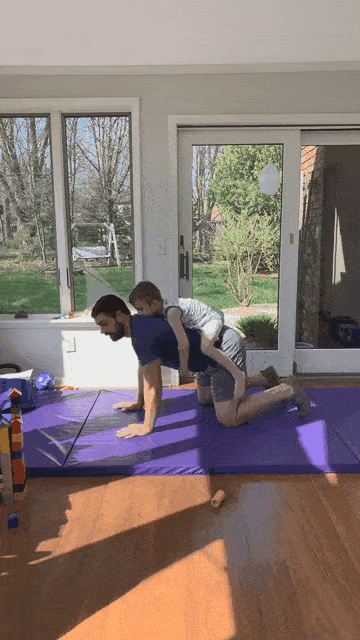
Crawling is a great functional fitness exercise that will help you stay mobile on the floor. A kiddo on your back will up the intensity of the workout.
Bonus points if you make growling and roaring noises.
#7) Goat Bag Hinge
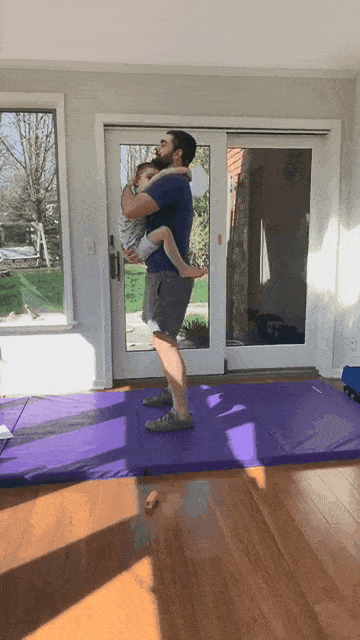
This exercise will have you strengthening your hinge muscles, kind of like you would in a kettlebell swing or deadlift.
Stand tall, clenching your kiddo, check to chest. Have them hold onto you too.
Push your hips back, again, like you would in a kettlebell swing. When your torso is parrellish to the ground, come back up, driving through your heels.
#8) Balancing
One leg balances can become a lot more challenging when your kid is trying to push you over:
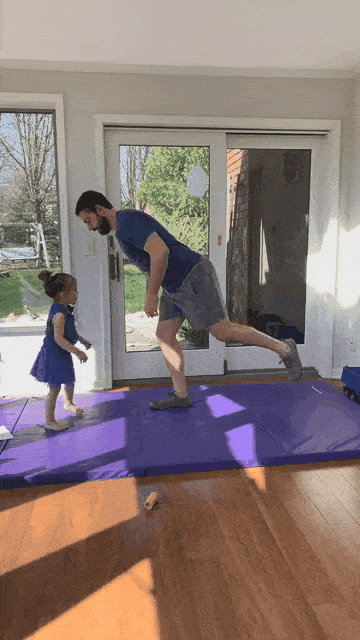
Another idea is to stand on one leg, then have your kid push you, and use that force to jump onto your other leg. Attempt to only use one leg at a time to balance:

Being able to lift your kid a few times for some exercises is great. But Coach Matt highlights that anything over 10 repetitions, probably isn’t happening.
The kids will get bored, whine, or revolt.
That’s why you might be better off playing some games with them.
Here are 10 fun and active games to play as a whole family:
#1) Ninja Training
This is easy: just ask your kiddos “Want to train like a ninja with me?”
If they’re into it, start practicing some of your jumps and crawls!
You can also hoist them up and help them hang from something (ninjas always have to climb up buildings), which would work if you have a pull-up bar:
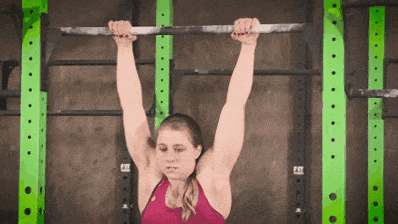
Don’t have a pull-up bar? We makeshift clever replacements in our guide to building a home gym.
Some house parkour might also be in the cards here.
#2) Chase (Cops and Robbers)
Here, you’re gonna build some type of fort. When playing this game, Coach Matt stands up his gymnastic mat tall and together, then places his kiddos in the middle.
Their job? Escape!
Run and track them down and send them back to jail (or your makeshift fort)
Feel free to teach them the phrase, “You’ll never catch me alive, coppers!”
#3) Freeze Ball
This might require a purchase, but foam dodgeballs are a great way to play with kids.
Have the different colored dodgeballs result in a different outcome:
#4) Animal Walks
Have someone call out an animal. Then everyone has to walk around like that!
Walking to Mordor is much tougher if you need to crawl like a snake for part of the journey.
#5) Hot Lava
With this game, you’re more or less building an obstacle course in your house, trying to jump from furniture to furniture…because the floor is now lava.
Here are some ideas on creating home obstacle courses:
Another fun way to start this game: start counting down from 5 out loud.
After “1” shout “hot lava” and if anyone is still on the normal floor, it’s time for them to start playing like Gollum when he finally got the ring:

This is a fun standing game to ensure spontaneous activity.
#6) Jump/Duck
This game is pretty easy: take an imaginary sword and swing high or low at the kiddos, or have them come at you with their imaginary weapon.
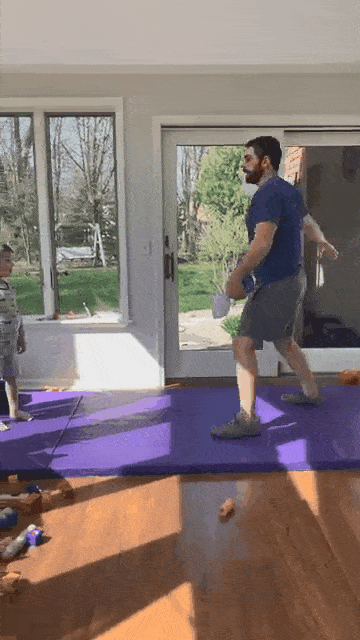
You need to either jump if they’re coming low, or duck if they’re coming high.
This is really simple, but lots of fun, and can be done with a group of people.
#7) King of the Log (Balance Challenges)
Much like the balance exercises we showed you earlier, but as a game!
Find some territory (a mat, some comfy carpet, grass) and try to push the other off it. Let your kiddos team up on you for a more even match.
#8) Wolf & Rabbit
Create a mark or identify a “safe place” within a short sprint away.
Have two people face each other, but keep enough distance that the “Rabbit” feels comfortable reaching safety.
The Rabbit stays frozen, until the Wolf makes a move. Then the Rabbit attempts to sprint to safety before the Wolf can tag it.
#9) Ninja Red Light, Green Light
If you’ve ever played “Red Light, Green Light” this is similar, although it involves some sneaking around, because ninjas.

“The Mark” walks around aimlessly, taking turns liberally, while the Ninja tries to sneak up behind and tag them.
If the Mark faces the Ninja, the Ninja must freeze.
Otherwise, the Ninja is free to tag the Mark.
#9) Commando
This game is kind of like Ninja Red Light, Green Light.
You have a Counter (normally the adult).
You have Runners (kids).
The Counter picks a number from five to ten, then counts down.
Before doing so, they announce “Fast” or “Slow.”
So twice as many “dots” are said allowed.
While the Counter counts, they move about (carefully) with their eyes closed. They make sure to turn around a lot to keep the Runners on their toes.
When the Counter reaches “1,” they freeze and open their eyes.
Any Runners caught in the Counter’s eyes has to do a silly “croak” finality.
Being quarantined at home is one thing. Being quarantined at home with your kids is quite another.
In the video above, streamed live to Nerd Fitness Prime members, “The Matts” talk to you about how they’re handling this new lifestyle.
Some highlights of the “Quarantine with Kids” discussion:
And much more!
If you’re juggling working remotely and homeschooling for the first time, give the video a watch.

The most important thing about working out with your kids: have fun!
If kids see you having fun, they might want to join you.
If you make your exercise together enjoyable by including some game elements, they might want to keep doing it.
That would be great!
If you need more ideas, here are 40 ways to exercise without realizing it.
However, if your kids are not into it, that’s okay. Just try to sneak in whatever workout you can, when you can.
These are unusual times, so our training will likely also be unusual.
Do the best you can. It’s something we bring up throughout our guide on How to Stay in Shape (While Staying Inside).
The most important thing you can do now: try an exercise or game with your kids!
You’ll never know how your kids deal with your workouts, until you try it out.
So pick one of the exercises or games we highlighted and give it a whirl.
If it devolves to chaos, you can always try again with a different workout or strategy.
Again, just do the best you can.

If you want some more help, Nerd Fitness is here for you.
We have three options on how to continue with us. Pick the option that best aligns with your goals:
Option #1) Liked the videos we showed in today’s guide? Want to watch them live and get your questions answered? Join Nerd Fitness Prime!
Nerd Fitness Prime is our premium membership program that contains at-home exercise routines, live-streamed workouts with NF Coaches, a supportive online community, group challenges, and much more!
Oh, and you can create a character and level up by completing real world challenges!
Option #2) If you want a professional coach in your pocket, who can do video form checks, provide feedback, and adjust your workouts based on the equipment you have available, check out our 1-on-1 Online Coaching Program!
For example, let’s say you find yourself stuck indoors during a pandemic, and you want somebody to custom-build you a workout program based on the equipment and furniture you have. That’s where an online coach is a game-changer!
Personally, I’ve been working with the same online coach since 2015 and it’s changed my life. You can learn more by clicking on the box below:
Option #3) Become part of the Rebellion! We need good people like you in our community, the Nerd Fitness Rebellion.
Sign up in the box below to enlist and get our Rebel Starter Kit, which includes all of our “work out from home” guides.
Alright, I want to hear from you and your experience with working out with your kiddos!
Are you a parent who is now learning how to exercise with your kids?
Any tips or tricks for training with screaming kids in the background?
Any fun games we missed?
Let me know in the comments!
-Steve
P.S. If you have older kids, they might be more into doing a workout right alongside you. If so, have them pick a routine from The 7 Best At-Home Workouts and try it together!
###
Photo Source: Cargo bike family, The clones are working hard, Family looking into sunset, Untitled, Simpson…Maggie Simpson.
Originally Posted At: https://breakingmuscle.com/feed/rss
This is one of those topics that rarely come up in discussions of weightlifting technique, but it can prove to be the cause of problems. One of them is that it may inhibit a lifter from making a best effort to complete a lifetime PR. I unknowingly developed my escapability when as a youngster my parents enrolled me in ju
http://www.marksdailyapple.com/
 Once you start making your own Instant Pot chicken bone broth, you’ll never buy salty packaged chicken broth from the store again. It’s fully prepped in minutes, you probably have all of the ingredients on hand, it costs pennies per serving, and we suspect you’ll make roast chicken a little more often knowing that a steaming pot of bone broth will follow.
Once you start making your own Instant Pot chicken bone broth, you’ll never buy salty packaged chicken broth from the store again. It’s fully prepped in minutes, you probably have all of the ingredients on hand, it costs pennies per serving, and we suspect you’ll make roast chicken a little more often knowing that a steaming pot of bone broth will follow.
A lot of people use the words “broth” and “stock” interchangeably, when in fact, they’re not prepared the same way. Each has its own characteristics and uses.
There’s no need to buy packaged broth when you can make your own easy and nutritious broth for a fraction of the price. All you need are the bones and carcass from roast chicken night, plus a few vegetable odds and ends you probably already have in your fridge or pantry. You can experiment with your favorite herbs, but any combination of thyme, sage, rosemary and parsley will work well.
The lemon is optional and does impart a stronger flavor on the broth. Additionally, adding a small amount of acid helps break down the bones, so you get a higher mineral content in your broth. If you plan to freeze the broth to use in a variety of dishes, you may want to leave the lemon out. If you plan to primarily use the broth immediately in soups or for sipping, the lemon is a lovely addition.
Here’s the easiest way to make bone broth.
1 previously roasted chicken carcass
2 large carrots, halved
2 stalks celery, halved
¼ onion
3 cloves garlic
1 small bunch thyme
1 small bunch sage
8-10 cups water
1 tsp. black peppercorns
Salt
1/4 lemon (optional)

If you are using an Instant Pot, place all of the ingredients in the pot except for the salt and top with water. Set the Instant Pot to “Pressure Cook” and cook at high pressure for 40 minutes. Allow the pressure to naturally release before removing the lid. Strain the broth and add salt to taste. Add to your favorite soups, stews, or just sip on its own.

No Instant Pot? If you are making the broth on the stove, place all of the ingredients in your pot. Bring the liquid in the pot to a boil and remove and scum that accumulates on the top of the liquid. (It’s not dangerous, but your broth will come out more clear if you remove it.)
Reduce the heat so the liquid is simmering and cover the pot. Simmer for about 2-3 hours, or until the broth is flavorful and the vegetables are very soft. Strain your broth and season with salt.
Use or consume your broth within 3-4 days, or freeze some in jars or containers for later.

The post Instant Pot Chicken Bone Broth Recipe (with Stovetop Option) appeared first on Mark’s Daily Apple.
http://www.thealternativedaily.com/
Antibacterial wipes have really come into their own lately. With the sudden, intense need to cleanse everything in sight to ensure it doesn’t harbor the dreaded virus, this handy sanitizing product has undoubtedly been featured on many household grocery lists. The problem is, many manufacturers and grocery suppliers haven’t been able to keep up with […]
http://www.marksdailyapple.com/

We forage for information in our minds the way we foraged for food as hunter-gatherers.
Full lockdowns don’t seem to have had much effect in Western Europe.
Deep genetic history of the Andes.
Factors most associated with death from COVID-19 in the UK: maleness, old age, uncontrolled diabetes.
More fitness, less dying.
Episode 421: Mark Sisson: Host Elle Russ chats with Mark Sisson, Miami mayo merchant.
Episode 422: Ben Greenfield: Host Brad Kearns chats with Ben Greenfield, biohacker and author of Boundless.
Primal Health Coach Radio, Episode 59: Laura and Erin talk about the advantages of small, simple coaching businesses with Karin Rozell.
Another reason to be suspicious of Beyond Meat and other alternative “meats.”
How a thru-hike changes your mind, body, and mitochondria.
How to slow down livestock growth in the event of meat packing plant closures.
Do stuff like this.
One doctor’s thoughts on flattening the curve.
This is true.
Why methane is different from other greenhouse gases.
During heart failure, the heart reduces glucose utilization. Restoring that glucose utilization prolongs and worsens the damage. Too bad there’s nothing else hearts can use for fuel…
Turns out car commuters who now work from home don’t miss the commute at all. Bike commuters stuck at home, however, do.
Podcasts I loved doing: The one with Brad Kearns over on his Get Over Yourself podcast and the one with Elle Russ on The Primal Blueprint Podcast.
Been wondering the same thing: Why are meat-packing plants coronavirus hotspots?
Study question I found interesting: Were World War 1 helmets better at blast wave protection than modern helmets?
Blog post I found to be important and relevant: Metabolic health in the time of COVID-19.
Podcast I enjoyed: The BBC one where someone actually reveals that livestock are probably carbon neutral.
Are things opening back up where you are?
One year ago (May 3 – May 9)
“I’m part of the Berkey cult. Before I bought mine about 5 years ago, I searched YouTube, and there were a whole mess of videos available, many by survivalist/prepper types. Some of them did send water samples to labs, which verified all the info on the Berkey website. I figured if the Berkey filter was good enough for crazy survivalists, it was good enough for me.”
– You make a strong point, Naomi.
The post Weekly Link Love – Edition 80 appeared first on Mark’s Daily Apple.